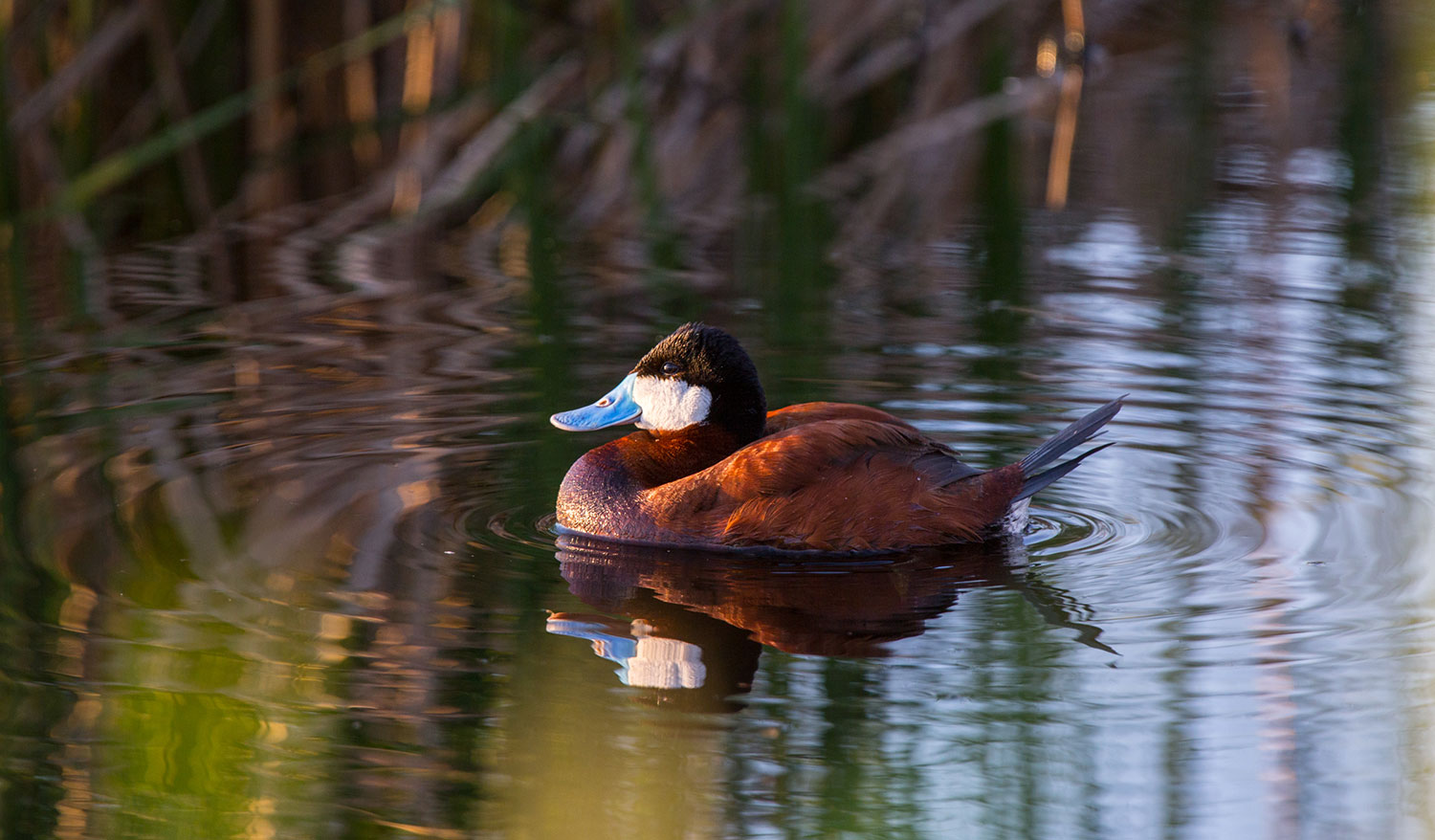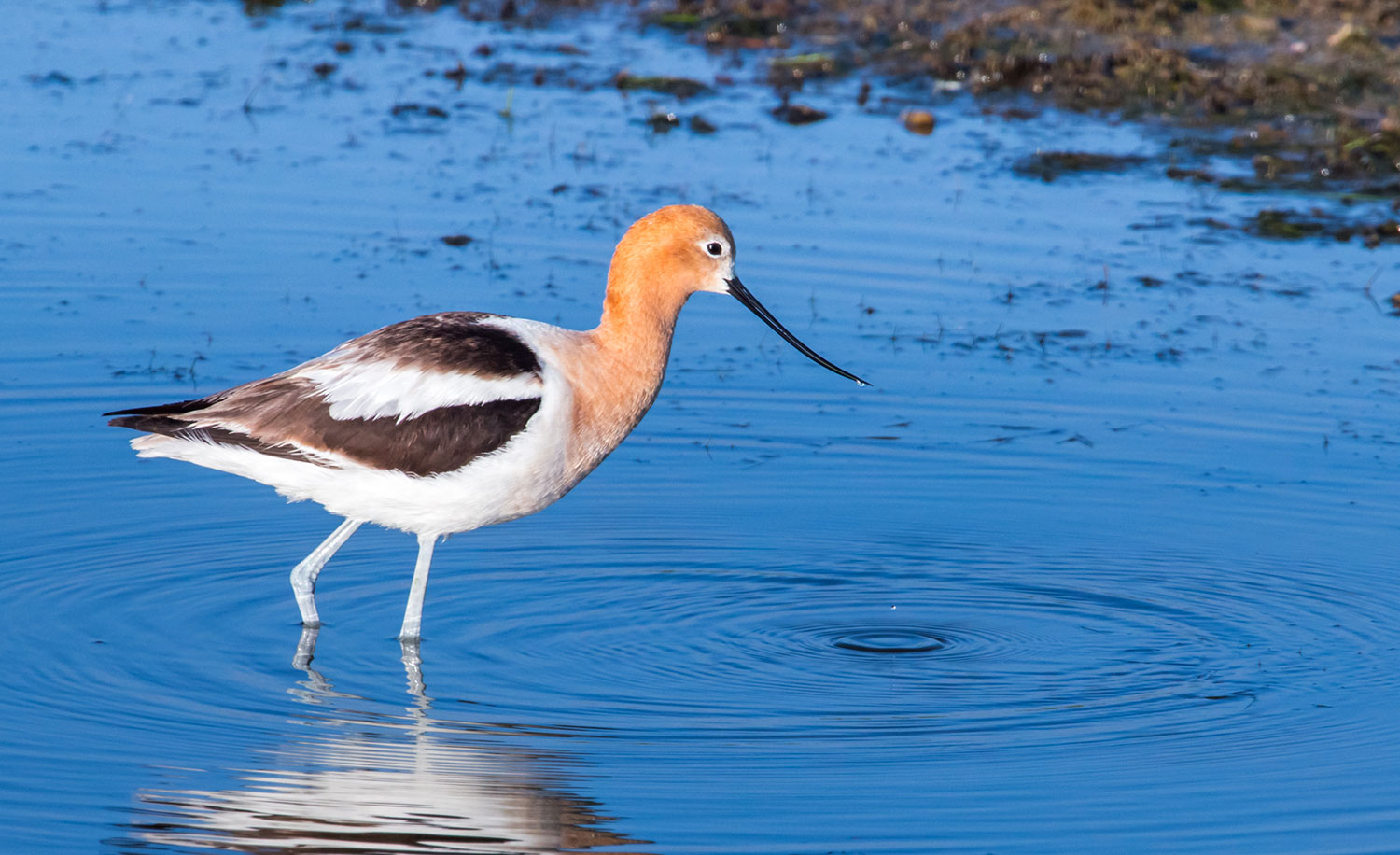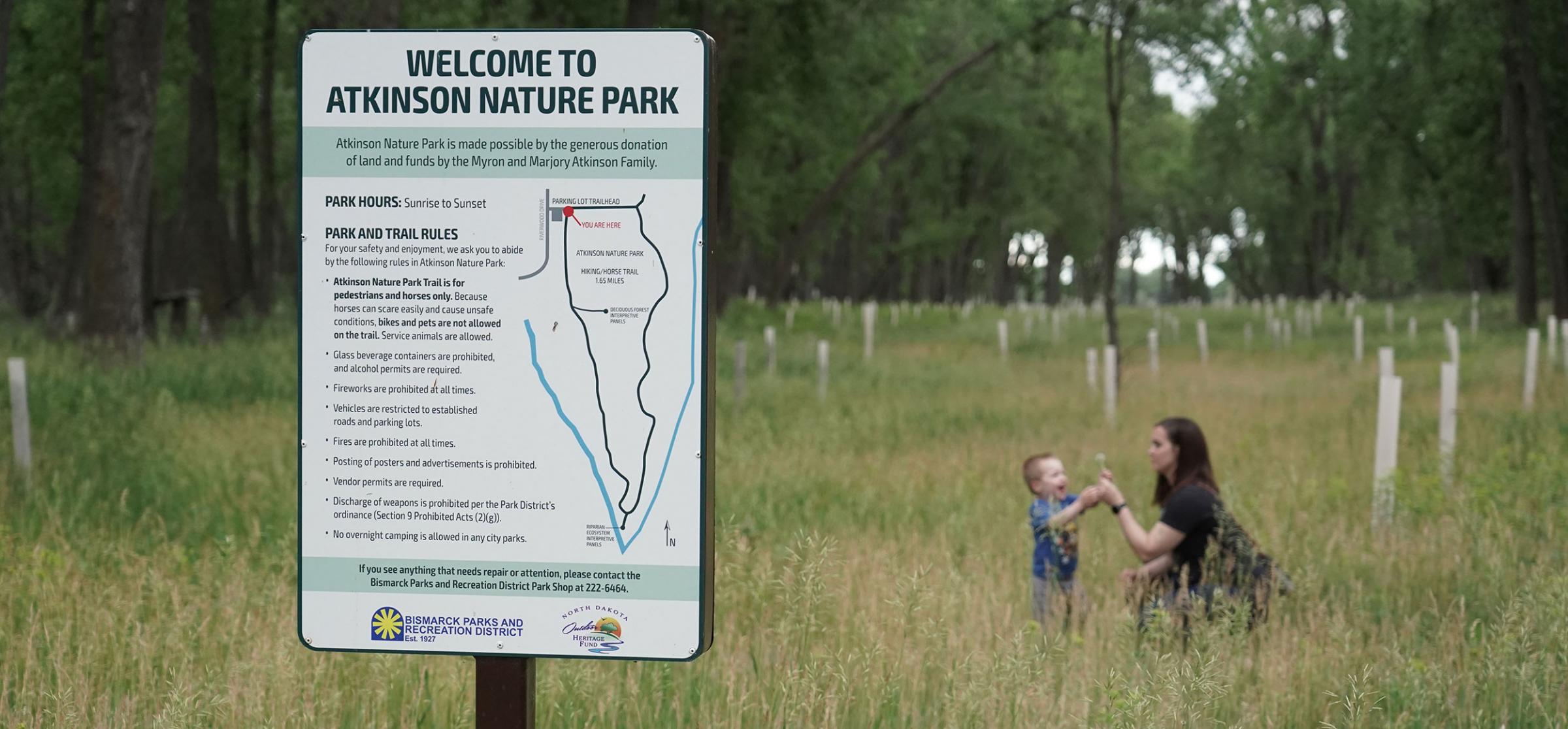“Listen,” my son says breathlessly, holding a small hand in the air as he scans the treetops. “It’s a woodpecker!”
Then he’s off, trotting down the trail with all the stealth a first-grader can muster. We never do spot the woodpecker, but we stand for a while longer, listening. The woodpecker’s rhythmic tapping weaves through a croaky chorus of frogs, the wind in the trees and the soaring trill of a bird that I’m certain I’ve never heard, despite a childhood spent tramping along riverbanks much like this one.

Ruddy duck
We spot a sleek, silvery bird crowned with a flash of blue and wonder if that’s what’s been calling us. Our pursuit takes us away from the bottomland forest and past anglers spread out on the bank, the murmur of their radio adding another soft melody. The man on the end reaches toward the can of corn at his feet and silently baits his hook. It lands in the clay-tinted waters of the Red River with a delicate plunk.
The path rises and circles through an orchard, where pink blossoms wait, clenched tight, ready to unfurl into one of the most fleeting and fragrant pleasures of a North Dakota spring. We nod to three generations of one family out for an afternoon stroll. The baby and the grandmother sport identical floppy sun hats. Nearby, a woman sits quietly under a tree. Her hands rest on her lap. The sense of perfect calm radiating from her is as tangible as the sun on my shoulders. The stress of the city feels far away.
But it’s not. We’re standing in Orchard Glen, just off South University Drive, one of Fargo’s main thoroughfares. Until just a few years ago, this was a neighborhood. Now this land, along with dozens of other new nature parks across North Dakota, is slowly and deliberately being reclaimed by native species – with a little help from Dakota Audubon and a host of partners through the Urban Woods and Prairies Initiative.
This unique project is the result of collaboration between outdoor enthusiasts, park districts, government agencies, nonprofit organizations, corporate donors, birders, business leaders, philanthropists, families, conservationists, farmers and ranchers across the state. It channels grants from resources like the North Dakota Outdoor Heritage Fund into converting land that’s difficult to graze, farm or build upon into thousands of acres of reclaimed prairie, wetland and woodland habitat. This habitat supports native species and adds accessible recreation opportunities for residents and visitors across the state.
It all started when a series of natural disasters presented an opportunity to think about the riverfront landscape in a different way. Marshall Johnson had just arrived in Fargo as the executive director of Audubon Dakota, an organization that conserves and restores natural ecosystems for birds and other wildlife in the Dakotas.
“Within three or four years, a number of cities, including Minot, Bismarck, Grand Forks and Fargo had experienced historic flooding and my organization launched our Bird-Friendly Communities,“ Johnson said. “Urban conversation was a place that we could really build out that program. I thought that land that was previously flood buy-out properties would be a good place to start.”

Forest River Nature Park trail - Nature parks are easy to access and provide country views in urban settings.
Audubon Dakota selected 500 acres along the Red River to convert into nature parks once the homes were removed. Organizers connected with several players, including the county, Federal Emergency Management Agency and the Fargo Park District, which would eventually come to own the land. Audubon Dakota proposed a long-term partnership.
Prairie Restorations, Inc., a company that specializes in maintaining natural habitat in the region, would do the initial site tests, remove nonnative species and plant appropriate grasses and flowers for each location. The Fargo Park District would provide ongoing maintenance. In return, Audubon Dakota would manage the nature parks, monitor the habitat, conduct plant and animal counts and install several miles of mixed-use trails for hiking and biking. The project broke ground in 2015.
“We said, ‘Instead of just dabbling here and there, let’s go grand and put enough areas around town that people are able to get to them if they can’t drive,’” said Fargo Park District director Dave Leker. “They (Audubon Dakota) had enough good ideas and enough sites.”
The Urban Woods and Prairies Initiative expanded to include 30 new nature parks in Fargo, Moorhead, Minn., Grand Forks, Valley City, Minot and Bismarck. The Fargo-Moorhead metro is home to 21 of them. Nearly 1,000 acres of natural habitat follows the Red River from Heritage Hills in the south to Cassel Woods well north of Hector International Airport.
There are dozens of access points on both sides of the river. Cyclists, runners and parents pushing strollers navigate paved trails through the grasslands of Unicorn Park and Pontes Prairie, while birders explore the wetlands within Briarwood Prairie. Even Frisbee golfers can get in on the action at Iwen Park. It’s located just off Hole 8 at a popular course. These extra amenities attract new users, but Leker said nature parks serve a greater purpose for the next generation.
“The biggest benefit is just kind of trying to bring some of the country and the native prairie into an urban setting,” he said. “While a lot of kids get out and hunt birds and pheasants, you can bring some of that into a part of town where kids can’t see that. We’ve got enough around town where they’re pretty accessible to everyone.”
Since native prairie typically takes three to five years to get established, the first five Fargo nature parks (Orchard Glen, Forest River, Heritage Hills, Unicorn Park and Briarwood Prairie) are now bursting into bloom. The return to a natural landscape is surprisingly colorful.

Tree in bloom
“Some of the pioneer species would be flowers like black-eyed Susan, rough vervain, and oxeye and coneflower,” said Blaine Keller, site manager at Prairie Restorations, Inc. Then dramatic purple blazing stars and a host of native grasses take over. “It can help educate the public to see that these types of areas can be beautiful and still be productive. They have a lot of diversity, a lot of flowers, a lot of grass species.”
A prairie in full bloom is a welcome sight for visitors, but it’s also a constant, sustainable buffet that benefits the entire ecosystem.
“Songbirds and butterflies have food sources throughout the season, so it allows them to thrive,” Keller said. “Projects like this are so important to add to the habitat for pollinators, since everything we grow needs these pollinators. Everything is intertwined.”
Flourishing bees and butterflies benefit the state’s farmers, ranchers and backyard gardeners. The healthy habitats that pollinators favor also support birds long absent from urban areas in large numbers, like waterfowl in wetlands and a resurgence of grassland birds, such as bobolinks and meadowlarks on the prairie. Look for owls in winter and (in Fargo-Moorhead especially) a steady stream of songbirds, including neotropical migrants that travel along the Central Flyway from Central America and the Yucatan. An accomplished birder in Fargo’s Forest River Nature Park might spot 25-30 different bird species in a single day in May or June.
“You’re immersed in nature,” said Johnson, describing the Forest River site. “All you can hear are fox calls and songbird calls and waterfowl and the life of the river. Most people want to drive an hour or two hours from Fargo to see nature, but right in our backyard, we’re able to get right on the river and experience nature in a fundamentally different way.”
Nature parks are easy to access. A bonus is that they’re also easy for parks officials to maintain, since they require limited mowing and minimal inputs.
“We’re supposed to be responsible stewards of the land, so I think it’s a great way of doing just that,” said Dave Bietz, Fargo Park District director of operations. “We don’t use nearly as much chemical inputs or adjustments that we do compared to a mowed turf or even just a mowed park. We fertilize those, we spray herbicides on those, but in a nature park we do very little. So, we’re doing something better for our environment and saving on fuel cost and labor cost.”
This combination of good stewardship, low cost and minimal maintenance caught the attention of leaders across the state. The wooded hiking and horseback riding trails of Atkinson Nature Park in Bismarck, sites in Minot’s Oak Park and several areas along the English Coulee in Grand Forks, have already started the transition into nature parks. More than a dozen additional sites are planned for these cities and West Fargo in years to come. Several are along the Missouri River in Bismarck.

Song bird
“Survey results have indicated a strong public interest to acquire more green space, to include natural areas,” said Randy Bina, Bismarck Parks and Recreation District executive director. “These areas provide non-structured recreational opportunities, such as bird watching, photography, walking, talking, biking.”
Tracie Bettenhausen of Bismarck recently discovered Bismarck’s Atkinson Nature Park for the first time. It gave her a different trail to hike and a new sense of perspective.
“Because this is preserved river bottom land, a trail like this gives you a chance to imagine time before Bismarck was here,” she said. “It’s good to see things not built by humans and give yourself a chance to focus on nature’s work.”
Nature parks offer a respite for all users, but hunters and anglers might especially appreciate them after a few long months spent indoors. Greg Link, conservation and communications division chief for North Dakota Game and Fish Department (a financial partner in the Urban Woods and Prairies Initiative) said that these accessible nature parks are especially important for recruiting, retaining and reactivating hunters and anglers, especially younger ones.
Hunters and anglers might also find themselves uniquely qualified to take up birding, said Ron H. Miller M.D. He got into the activity himself after noticing birds along trout streams where he went fly-fishing. He’s now a contributor to the Urban Woods and Prairies Initiative and teaches birding courses for the Fargo Park District.
”Fishermen see a lot of birds that you wouldn’t see just walking through a field – shorebirds like the great blue heron, green herons, sandpipers, loons,” Dr. Miller said. “Some of the best initial birders are hunters. If you’ve ever been a waterfowl hunter, you can recognize the difference between a pintail and a coot on the wing – and that’s a difficult thing. Hunting from a deer stand, you’re hunting deer but you’re watching everything. So, you see the owls come in, you see the hawks come in. You see birds you don’t see in your backyard. Anybody that likes the outdoors is going to enjoy birding.”

Leopard frog
Urban nature parks are designed to make it easy for anyone to see birds and other wildlife up close. This spring’s social distancing requirements have introduced a whole new group of users to the outdoors.
“In an urban area, people can come and throw in a line, canoe, kayak. Even kids on bikes can come in. You see people around Bismarck on the trails,” Link said. “It’s really becoming apparent during this pandemic that those kinds of opportunities are really important – families just kind of getting away and getting outside and getting some fresh air.”
Bill Brooks, 15, and his family have been doing exactly that. While home from school this spring, the Fargo teen scoured maps for quiet nature parks to explore.
“Now that we’ve been stuck inside, this is one thing that we can do and still avoid a lot of people and maintain our distance,” he said. “I’ve really taken an interest in this because it’s a fun activity that you can still be safe doing.”
Bill advises hikers to check out Lemke Conservancy Park for its seclusion and scenic trail. Both he and his mother, Emily Brooks, also recommend Lions Conservancy Park, which they discovered after noticing a sign near their home. They’ve enjoyed walking the riverside and grassland trails, with geese and the occasional bald eagle flying overhead, in all seasons.
“It’s just absolutely gorgeous during the fall, especially if you can get to a location where there’s no wind, because all of those vibrant colors reflect off the water in the Red River,” Emily said. “It doesn’t feel like you’re in Fargo.”
That’s exactly the feeling Audubon Dakota and its partners were hoping to evoke when they started the Urban Woods and Prairies Initiative. Now that more people have experienced how transformative native habitat can be, interest is soaring. And Audubon Dakota is happily fielding calls from new partners.
“We’ve been approached by a number of private property owners who are interested in selling,” Johnson said. “We’ve always sought to create favorable terms for our landowners. Most of this land is not ideal for any type of commercial development. We come in to manage the land in perpetuity, and that’s a high cost that some private and public landowners don’t have the budget for. That’s what we commit to early on, spearheading the conservation efforts. We make them really great nature parks as they would have been before development.”

American avocet
One of those landowners is Dick Monson, a retired farmer from Valley City. He remembers the untamed prairie of his youth. And he wants it back.
“When I was a kid in the early 1950s, our pasture had burrowing owls and there were meadowlarks on the corner posts and every big rock out there,” he said. “I haven’t seen an owl for 60 years and the meadowlarks are disappearing, along with other grassland songbirds, as the native prairie slips away.”
He’s doing what he can to help, transferring some of the acreage to Audubon Dakota for a new nature park that he bought from the railroad 20 years ago. A portion of Monson’s land was never cleared or grazed. It offers a peek at the biological diversity that awaits other plots slated to become nature parks – diversity many modern residents have never seen.
“There are wild tiger lilies, closed gentians, coneflowers, just a host of native flowers and plants that are seldom seen in eastern North Dakota anymore,” Monson said. “They blossom season long. In the draws there are plum, chokecherry and juneberry bushes. It makes a nice wildlife habitat and is worth preserving.”
That’s what the Urban Woods and Prairies Initiative is all about. This unique project gathers a varied group of outdoor advocates from all over the state. They have different passions and goals for the project, but they all have one thing in common. They all believe that what’s good for wildlife is good for humans, too. And they’re willing to help build and preserve the habitat we all need.







